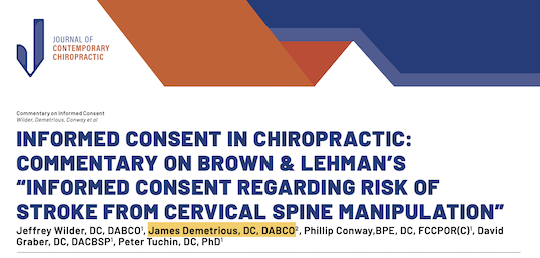Critically Appraising Informed Consent and Stroke Risk: Assessing the Narrative Review by Brown & Lehman
Written by: James Demetrious, DC, DABCO
Introduction
Informed consent represents a cornerstone of ethical healthcare practice, ensuring patient autonomy while striking a balance between professional responsibility and patient autonomy. For chiropractic physicians, this involves a careful disclosure of foreseeable risks associated with spinal manipulation.
Recently, Brown and Lehman (2025) recommended universal inclusion of cervical artery dissection (CAD) and stroke as risks in chiropractic informed consent for cervical spine manipulation (CSM). While their stated aim of maximizing patient protection is commendable, a closer examination of their arguments reveals limitations in evidentiary support, internal consistency, and medico-legal applicability.
I am grateful for the opportunity to co-author and publish a critical review of the Brown/Lehman article alongside distinguished leaders in the chiropractic profession.
Use of Epidemiologic Evidence
Brown and Lehman cite well-regarded epidemiological studies, including those by Cassidy, Kosloff, Church, and Whedon. These studies consistently conclude that there is no demonstrable causal link between CSM and stroke. Instead, they highlight the likelihood of patients with evolving dissections seeking care for neck pain or headache prior to stroke onset, independent of manipulation.
Despite this, Brown and Lehman reinterpret the findings to suggest that manipulation could trigger thromboembolic events in predisposed patients. This reinterpretation diverges from the published conclusions and risks overstating a causal connection not supported by high-level evidence.
Biomechanical Considerations
A central claim in Brown and Lehman’s review is that CSM could dislodge a pre-existing thrombus. However, they do not provide empirical biomechanical data to substantiate this assertion. By contrast, multiple high-quality studies (Herzog, Symons, Gorrell, Wuest, Fagundes) demonstrate that manipulative forces are insufficient to exceed arterial strain thresholds known to produce vascular injury. The absence of biomechanical validation renders their claim speculative rather than evidence-based.
Reliance on Low-Level and Anecdotal Sources
A significant portion of their argument is supported by narrative reviews, case reports, opinion pieces, and even references from anti-chiropractic websites. According to Sackett’s hierarchy of evidence, these sources fall into Levels 4–5, the least reliable for guiding clinical standards. They conclude only that “plausible mechanisms” may exist, without presenting biomechanical corroboration. Elevating such literature to justify universal informed consent obligations raises concerns about evidentiary sufficiency.
Selective Citation and Omission of Contradictory Evidence
The omission of large-scale, contradictory findings further limits the neutrality of their review. For example, Whedon et al. examined data from over 300 million person-years and reported no significant association between CSM and CAD or stroke, even in higher-risk Medicare populations. Excluding such pivotal findings risks creating an unbalanced narrative that does not reflect the broader state of the evidence.
Internal Inconsistencies
Brown and Lehman acknowledge that there is no evidence demonstrating CSM causes dissection in otherwise healthy arteries. Yet they simultaneously recommend informing every patient that manipulation may pose such a risk. Similarly, while conceding that manipulative forces are biomechanically minimal, they speculate about thrombus dislodgement without supporting data. These contradictions weaken the coherence of their recommendations.
Legal and Ethical Considerations in Informed Consent
Informed consent standards are grounded in the concept of “material risk,” requiring disclosure of risks that are foreseeable and causally attributable to treatment. Jurisprudence varies by jurisdiction. Brown and Lehman’s proposal to universally disclose CAD and stroke risk may therefore extend beyond legal precedent, potentially conflating speculation with duty. Such an approach risks introducing unwarranted fear, stigmatizing chiropractic care, and creating unnecessary medico-legal exposure.
Clinical Implications
Taken together, Brown and Lehman’s conclusions rest largely on selective citation, low-level evidence, and speculative mechanisms rather than validated biomechanical or epidemiologic findings. For chiropractic practitioners, an evidence-informed approach to informed consent should be guided by:
- The best available research, which does not demonstrate a causal relationship between CSM and CAD/stroke;
- Applicable statutory and jurisdictional requirements regarding disclosure;
- Professional judgment, grounded in accredited training and legal counsel.
Conclusion
While Brown and Lehman’s intent to enhance patient safety is laudable, their call for universal disclosure of CAD and stroke risk is not supported by high-quality evidence. Informed consent must remain both patient-centered and evidence-based. Universal disclosure of risks that remain speculative may mislead patients, distort clinical realities, and inadvertently undermine trust in chiropractic care. Ultimately, informed consent should reflect verifiable knowledge rather than conjecture, thereby supporting both patient autonomy and professional integrity.
References
References associated with this article are available in our published JCC paper.
Disclosure
The information provided in this article and all PostGradDC coursework should not be considered standards of care. We provide this information for educational purposes only. This information is not intended to be a substitute for professional medical advice, diagnosis, or treatment. Always consult your physician or a qualified healthcare provider with any questions you may have regarding medical conditions or treatment. Seek the opinion of your legal representative. Errors and omissions are unintended.
Conflict of Interest Statement
Dr. James Demetrious is a board-certified chiropractic orthopedist and the founder and owner of PostGradDC (PostGradDC.com), a privately operated provider of chiropractic continuing education. Dr. Demetrious is a member of the NCMIC Speakers’ Bureau. Dr. Demetrious teaches coursework on behalf of chiropractic colleges, state, and national organizations. Dr. Demetrious has published peer-reviewed research on these topics and provides consultation services to chiropractic physicians, attorneys, and professional organizations.
This commentary was written independently and without external funding. While his educational and advocacy activities promote evidence-based chiropractic practice, the views expressed herein are his own and are based on an interpretation of the current scientific literature. Any omissions are unintended, and concerns about COI can be amended.

PostGradDC offers advanced post-graduate chiropractic continuing education. Our founder, Dr. James Demetrious, is a distinguished board-certified chiropractic orthopedist, educator, author, and editor.
© 2025 – James Demetrious, DC, DABCO. Open Access. Unrestricted use, distribution, and reproduction are allowed in any medium, provided you give appropriate credit by citing the original author and source: Demetrious J. PostGradDC. Critically Appraising Informed Consent and Stroke Risk: Assessing the Narrative Review by Brown & Lehman. PostGradDC.com; 2025.

